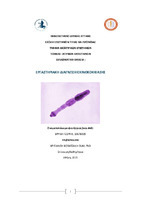Εργαστηριακή διάγνωση εχινοκοκκίασης
Laboratory diagnosis of echinococcosis

Λέξεις-κλειδιά
ΕχινοκοκκίασηΠερίληψη
Η εχινοκοκκίαση είναι μια παραμελημένη παρασιτική νόσος με παγκόσμια κατανομή, που
προκαλείται από είδη του γένους Echinococcus. Τα μολυσματικά αυγά του παρασίτου
εισέρχονται στο ανθρώπινο έντερο, όπου εκκολάπτονται και απελευθερώνουν την
ογκόσφαιρα, η οποία εξελίσσεται σε υδατίδα κύστη. Οι κύστεις εντοπίζονται κυρίως στο
ήπαρ. Η παρούσα μελέτη επικεντρώνεται στην ανασκόπηση μεθόδων εργαστηριακής
διάγνωσης της κυστικής και της κυψελιδικής εχινοκοκκίασης. Η κυστική μορφή, η
συχνότερη, προκαλείται από το Echinococcus granulosus (Ε. granulosus), ενώ η κυψελιδική,
η πιο απειλητική για την υγεία, οφείλεται στο Echinococcus multilocularis (E. multilocularis).
Η εργαστηριακή διάγνωση βασίζεται σε απεικονιστικές τεχνικές, όπως η αξονική
τομογραφία (CT), η μαγνητική τομογραφία (MRI) και το υπερηχογράφημα. Επιπλέον
αξιοποιούνται ορολογικές μέθοδοι όπως η ανοσοαποτύπωση κηλίδας (Dot blot), ενζυμική
ανοσοδοκιμασία χημειοφωταύγειας (CLIA) και ενζυμική ανοσοπροσροφητική δοκιμασία
(ELISA), δοκιμασίες ανίχνευσης βιοδεικτών, όπως η εξοκινάση (HK) και ο διαλυτός
υποδοχέας της IL-33 (sST2), και η ανίχνευση αντιγόνων του E. granulosus με
ανοσοχρωματογραφία. Επιπρόσθετα, βρίσκεται υπό διερεύνηση η διαγνωστική
χρησιμότητα της ανίχνευσης microRNA, ελεύθερου κυτταρικού DNA (cfDNA), και κυκλικών
μορίων RNA (circRNA). Η συνδυαστική χρήση απεικονιστικών, ορολογικών και μοριακών
μεθόδου μπορεί να οδηγήσει στην έγκαιρη διάγνωση της νόσου συμβάλλοντας στην
αποτελεσματική θεραπευτική αντιμετώπιση των ασθενών.
Περίληψη
Echinococcosis is a neglected parasitic disease with a global distribution, caused by species
of the genus Echinococcus. The infectious eggs of the parasite enter the human intestine,
where they hatch and release the oncosphere, which develops into a hydatid cyst. The cysts
are primarily located in the liver. This study focuses on reviewing laboratory diagnostic
methods for cystic and alveolar echinococcosis. The cystic form, which is the most common,
is caused by Echinococcus granulosus (E. granulosus), while the alveolar form, which is more
threatening to health, is caused by Echinococcus multilocularis (E. multilocularis). Laboratory
diagnosis is based on imaging techniques such as computed tomography (CT), magnetic
resonance imaging (MRI), and ultrasound. Additionally, serological methods are utilized,
such as immunoblotting (Dot blot), chemiluminescence immunoassay (CLIA), and enzyme
linked immunosorbent assay (ELISA), as well as biomarker detection tests, including
hexokinase (HK) and the sST2) , along with antigen detection of E. granulosus via
immunochromatography. Furthermore, the diagnostic potential of microRNA detection, free
circulating DNA (cfDNA), and circular RNA molecules (circRNA) is under investigation. The
combined use of imaging, serological, and molecular methods can lead to the timely
diagnosis of the disease, contributing to the effective therapeutic management of patients

